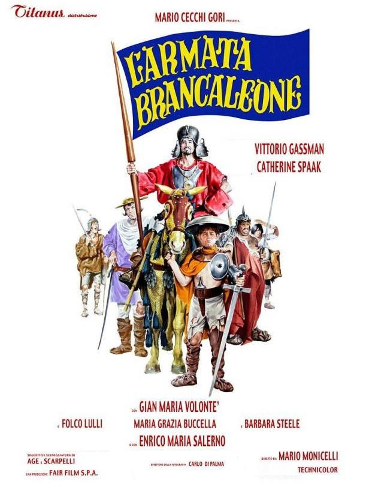An immortal classic of Italian comedy
The film that invented a language and reinvented the Italian middle ages
Nastro d’argento 1967 for best colour cinematography, Carlo di Palma, for best costumes, Piero Gherardi, and for best music, Carlo Rustichelli
The dirty and miserable Middle Ages as depicted in L’Armata Brancaleone are a surprising rediscovery for every new generation fortunate enough to see it. The historical documentation behind the film is noteworthy, but the filmmakers (director and screenwriters Age & Scarpelli) went out of their way to hide it. They constructed a film of uncontainable vitality, with characters that have remained in the collective memory. A film of rich intellectual quality that anyone can understand, even if they haven’t read Don Quixote or only have a vague knowledge of the Commedia dell’Arte. The film has kept audiences laughing ever since its release, even though at times, as in all of Monicelli’s best work, death rears its head and fear takes over. Here, Gassman is sublime, more comic than heroic, parodying his own classic acting style. Other great performances include Gian Maria Volontè as a disgraced Byzantine nobleman, and Catherine Spaak as a virgin that makes your legs go weak. They speak a language that has become part of Italian culture, mixing Jacopone da Todi, the Marche dialect, stately discourse and the macaronic style, with the rest completely made up. The chorus “Branca Branca Branca, Leon Leon Leon!” is one of the most sung songs ever in Italy.
In ragged and greedy medieval Italy, the bold Brancaleone wanders around at the command of a small, haggard group of armed men. He saves maidens but does not take advantage of them, he escapes the Byzantines by the skin of his teeth, he fights the Saracens and narrowly avoids being impaled. He is saved by a monk, Zenone, who takes him to the Holy Land, where the Crusades await.
An immortal classic of Italian comedy
The film that invented a language and reinvented the Italian middle ages
Nastro d’argento 1967 for best colour cinematography, Carlo di Palma, for best costumes, Piero Gherardi, and for best music, Carlo Rustichelli
The dirty and miserable Middle Ages as depicted in L’Armata Brancaleone are a surprising rediscovery for every new generation fortunate enough to see it. The historical documentation behind the film is noteworthy, but the filmmakers (director and screenwriters Age & Scarpelli) went out of their way to hide it. They constructed a film of uncontainable vitality, with characters that have remained in the collective memory. A film of rich intellectual quality that anyone can understand, even if they haven’t read Don Quixote or only have a vague knowledge of the Commedia dell’Arte. The film has kept audiences laughing ever since its release, even though at times, as in all of Monicelli’s best work, death rears its head and fear takes over. Here, Gassman is sublime, more comic than heroic, parodying his own classic acting style. Other great performances include Gian Maria Volontè as a disgraced Byzantine nobleman, and Catherine Spaak as a virgin that makes your legs go weak. They speak a language that has become part of Italian culture, mixing Jacopone da Todi, the Marche dialect, stately discourse and the macaronic style, with the rest completely made up. The chorus “Branca Branca Branca, Leon Leon Leon!” is one of the most sung songs ever in Italy.
In ragged and greedy medieval Italy, the bold Brancaleone wanders around at the command of a small, haggard group of armed men. He saves maidens but does not take advantage of them, he escapes the Byzantines by the skin of his teeth, he fights the Saracens and narrowly avoids being impaled. He is saved by a monk, Zenone, who takes him to the Holy Land, where the Crusades await.


